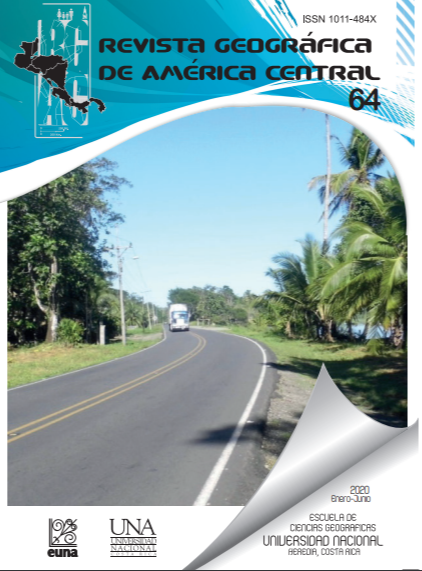Contributions from genetic conservation to the improvement of urban green spaces
DOI:
https://doi.org/10.15359/rgac.64-1.2Keywords:
Genetic conservation, Landscape genetics, Landscape ecology, Urban areas, Urban green spaces, CityAbstract
The potential use of the precepts and concepts of genetic conservation in urban green spaces is examined through a theoretical reflection. Usually, urban green spaces are considered as part of the urban real-estate and its use is frequently associated with an aesthetic aspect of the city. Its planning does not consider technical nor scientific aspects. Additionally, studies of cities disregard the genetic conditions of species in an environment generally already considered hostile. It is proposed the development of genetic conservation studies to improve the quality of the biological diversity in urban green spaces with evermore functional purposes.
References
Arnberger, A. (2012). Urban densification and recreational quality of public Urban green spaces-A viennese case study. Sustainability, 4(4), 703-720. Recuperado de https://doi.org/10.3390/su4040703
Bettini, V. (1998). Elementos de una ecología urbana (1st ed.). Madrid: Editotial Trotta, S.A.
Burguillos, L., Parra, L. & Wagner, E. (2008). Human, ecologican, and biophysical dimensions of tropical dry forests. Manual of methods. Human, Ecologican, and Biophysical Dimensions of Tropical Dry Forests.
Calthorpe, P. & Van der Ryn, S. (1986). Sustainable Communities: A New Design Synthesis for Cities, Suburbs and Towns. San Francisco: Sierra Club Books.
Carpenter, S. R. & Turner, M. G. (2007). A Decade of Ecosystems. Ecosystems, 10(4), 519–522. Recuperado de https://doi.org/10.1007/s10021-007-9044-9
Carreiro, M. M., Song, Y.C. & Wu, J. (2008). Ecology, Planning, and Management of Urban Forests. (M. M. Carreiro, Y.-C. Song, & J. Wu, Eds.). New York, NY: Springer New York. Recuperado de https://doi.org/10.1007/978-0-387-71425-7
Fahrig, L. (1997). Relative effects of habitat loss and fragmentation on population extinction. The Journal of Wildlife Management, 61(3), 603–610.
Fahrig, L. (2003). Effects of Habitat Fragmentation on Biodiversity. Annual Review of Ecology, Evolution, and Systematics, 34(1), 487–515. Recuperado de https://doi.org/10.1146/annurev.ecolsys.34.011802.132419
Fernández, I. C. (2017). Planning for Urban Ecosystem Services : Generating Actionable Knowledge for Reducing Environmental Inequities in Santiago de Chile. Arizona State University.
Forman, R. T. T. & Godron, M. (1986). Landscape ecology. New York: John Wiley & Sons.
Gazmararian, J., Kripalani, S., Miller, M., Echt, K., Ren, J. & Rask, K. (2006). Factors Associated with Medication Refill Adherence in Cardiovascular-related Diseases: A Focus on Health Literacy. J Gen Intern Med, 21(4), 1215–1221. Recuperado de https://doi.org/10.1111/j.1525-1497.2006.00591.x.
Geburek, T. & Konrad, H. (2008). Why the conservation of forest genetic resources has not worked. Conservation Biology, 22(2), 267–274. Recuperado de https://doi.org/10.1111/j.1523-1739.2008.00900.x
Harnik, P. (2000). Inside City Parks. Urban Land Institute.
Harnik, P. (2003). The Excellent City Park System: What Makes it Great an How to Get There. The Trust for Public Land.
Higueras, E. (2006). Urbanismo bioclimático (1st ed.). Barcelona: Editorial Gustavo Gill.
Johnson, L. R. (2013). Long-term outcomes of ecological restoration and management in urban forest patches. The State University of New Jersey.
Kramer, A. T., Ison, J. L., Ashley, M. V. & Howe, H. F. (2008). The paradox of forest fragmentation genetics. Conservation Biology, 22(4), 878–885. Recuperado de https://doi.org/10.1111/j.1523-1739.2008.00944.x
Manel, S. & Holderegger, R. (2013). Ten years of landscape genetics. Trends in Ecology & Evolution, 28(10), 614–621. Recuperado de https://doi.org/10.1016/j.tree.2013.05.012
McGarical, K. & Marks, B. J. (1994). FRAGSTATS: Spatial Pattern Analysis Program for Quantifying Landscape Structure. General Technical Report PNW-GTR-351. US … 97331(503), 134.
Millward, A. A. & Sabir, S. (2010). Structure of a forested urban park: Implications for strategic management. Journal of Environmental Management, 91(11), 2215–2224. Recuperado de https://doi.org/10.1016/j.jenvman.2010.06.006
Odum, E. P. (1971). Fundamentals of Ecology. Philadelphia: Saunders.
Pellissier, V., Cohen, M., Boulay, A. & Clergeau, P. (2012). Birds are also sensitive to landscape composition and configuration within the city centre. Landscape and Urban Planning, 104(2), 181–188. Recuperado de https://doi.org/10.1016/j.landurbplan.2011.10.011
Shanahan, D. F., Lin, B. B., Gaston, K. J., Bush, R. & Fuller, R. A. (2015). What is the role of trees and remnant vegetation in attracting people to urban parks? Landscape Ecology, 30(1), 153–165. Recuperado de https://doi.org/10.1007/s10980-014-0113-0
Tello, E. (1996). Ciudades sostenibles: un cambio de rumbo. Mientras Tanto, (64), 35–61. Recuperado de http://www.jstor.org/stable/27820253 Ciudades sostenibles
Verrelli, B., Dowling, T. & Wojciechowski, M. (2013). Spatial and temporal patterns of population genetic diversity in the fynbos plant , Leucadendron salignum , in the Cape Floral Region of South Africa by Erica Tassone (A Dissertation Presented in Partial Fulfillment of the Requirements for the Degree Docto), (May).
Wackernagel, M. (1996). ¿Ciudades sostenibles? Ecología Política, (12), 43–50. Recuperado de http://www.jstor.org/stable/20742894
Wagner, J. L. (2013). Evolution of a sustainable park: Forest Park, St. Louis, Missouri. Saint Louis University.
Downloads
Published
How to Cite
Issue
Section
License
Proposed policy for journals offering Open Access
Authors publishing their works in the Journal acknowledge and agree to the following terms:
a) Authors retain the copyrights to their works and guarantee the Journal the right to be the first to publish their works, under the Creative Commons License Attribution-NonCommercial-ShareAlike 4.0 International, CC BY-NC-SA 4.0 International (https://creativecommons.org/licenses/by-nc-sa/4.0/deed.es), which allows others to share works upon complying with the acknowledgment of authorship and mention of the Journal as the original publisher of the work.
b) Authors are permitted to separately establish additional agreements for the non-exclusive distribution of the official edition of the work published in the Journal (for example, authors may desire to place the work in an institutional repository or incorporate it into a book that is to published elsewhere) so long they acknowledgment to recognize the Journal as the original publisher. The aforementioned additional agreements must respect the terms of the non-profit character and sharing philosophy of the original license (CC BY-NC-SA 4.0 International, https://creativecommons.org/licenses/by-nc-sa/4.0/deed.es).
c) Authors are encouraged to archive the post-print or editor/PDF version in Open Access repositories.






 REVGEO is licensed under https://creativecommons.org/licenses/by-nc-sa/4.0/deed.es
REVGEO is licensed under https://creativecommons.org/licenses/by-nc-sa/4.0/deed.es
.svg_4.png)

_(1).png)
_(1)_(1)_(1)_1.png)
(2)(1)(1)(1).png)
